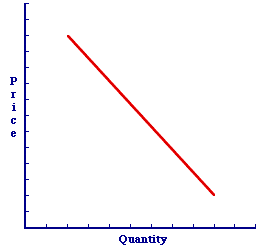
|
|
LIMITED RESOURCES: Finite quantities of labor, capital, land, and entrepreneurship available to an economy for the production of goods and services. This is one half of the fundamental problem of scarcity that has plagued humanity since the beginning of time. The other half of the scarcity problem is unlimited wants and needs.
Visit the GLOSS*arama
|
|


|

|
                           BUYERS' INCOME, DEMAND DETERMINANT: The income that buyers have available to purchase a good, which is assumed constant when a demand curve is constructed. Buyers' income is one of five demand determinants that shift the demand curve when they change. The other four are buyers' preferences, other prices, buyers' expectations, and number of buyers. Buyers' income affects the ability to purchase a good. In general, income has a direct affect on the ability to buy a good, that is, more income means more buying. However, income can actually affect demand in two ways. For normal goods, more income means more demand. For inferior goods, however, more income means less demand.Normal and InferiorWhen it comes to the buyers' income demand determinant, goods fall into one of two types--normal and inferior.- Normal Good: A normal good exists when buyers are inclined to buy more of the good if they have more income. A normal good is so named because it represents the typical, or "normal" situation. An increase in income means buyers have a greater ability to purchase goods. As such, buyers are "normally" inclined to buy more if they have more income.
- Inferior Good: An inferior good exists when buyers are inclined to buy less of the good if they have more income. An inferior good is so named because it tends to be less expensive than more desirable goods. As such, when buyers have more income and can afford to buy the more expensive products, then they reduce their purchases of the inferior goods.
Shifting the Demand Curve| Buyers' Income | 
|
A change in buyers' income causes the demand curve to shift. This can be illustrated using the negatively-sloped demand curve for Wacky Willy Stuffed Amigos presented in this exhibit. This demand curve captures the specific one-to-one, law of demand relation between demand price and quantity demanded. Buyers' income is assumed to remain constant with the construction of this demand curve.Now, consider how changes in buyers' income shifts the demand curve. The demand curve is affected in a different way for normal goods than for inferior goods. - Normal Good: An increase in buyers' income causes an increase in demand and a rightward shift of the demand curve for a normal good. Click the [Income Increase] button under the Normal Good heading to demonstrate.
A decrease in buyers' income causes a decrease in demand and a leftward shift of the demand curve for a normal good. Click the [Income Decrease] button under the Normal Good heading to demonstrate.
- Inferior Good: An increase in buyers' income causes a decrease in demand and a leftward shift of the demand curve for an inferior good. Click the [Income Increase] button under the Inferior Good heading to demonstrate.
A decrease in buyers' income causes an increase in demand and a rightward shift of the demand curve for an inferior good. Click the [Income Decrease] button under the Inferior Good heading to demonstrate.
Not the Income EffectThe buyers' income demand determinant needs to be distinguished from a seemingly similar notion, the income effect.- Buyers' Income Demand Determinant: Buyers' income is a demand determinant that affects the ability to purchase a good, given no change in the price of the good. The change in buyers' income causes a change in demand and a shift of the demand curve. With the buyers' income demand determinant, price is fixed and income changes.
- Income Effect: The income effect results from a change in demand price, which affects the purchasing power of a given amount of income. The change in purchasing power then causes a change in quantity demanded and a movement along the demand curve. With the income effect, price changes and income is fixed.

Recommended Citation:BUYERS' INCOME, DEMAND DETERMINANT, AmosWEB Encyclonomic WEB*pedia, http://www.AmosWEB.com, AmosWEB LLC, 2000-2025. [Accessed: July 18, 2025].
Check Out These Related Terms... | | | | | | | | |
Or For A Little Background... | | | | | | | | | |
And For Further Study... | | | | | | |
Search Again?
Back to the WEB*pedia
|



|

|
RED AGGRESSERINE
[What's This?]
Today, you are likely to spend a great deal of time at a flea market wanting to buy either a weathervane with a cow on top or a box of multi-colored, plastic paper clips. Be on the lookout for telephone calls from long-lost relatives.
Your Complete Scope
This isn't me! What am I?
|

|
|
Two and a half gallons of oil are needed to produce one automobile tire.
|

|
|
"A winner is someone who recognizes his God-given talents, works his tail off to develop them into skills, and uses those skills to accomplish his goals. " -- Larry Bird, basketball player
|

|
QML
Quasi-Maximum Likelihood
|

|
|
Tell us what you think about AmosWEB. Like what you see? Have suggestions for improvements? Let us know. Click the User Feedback link.
User Feedback
|


|


